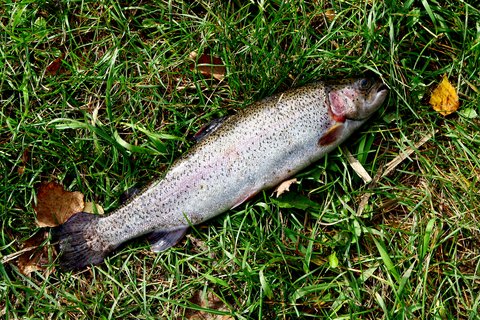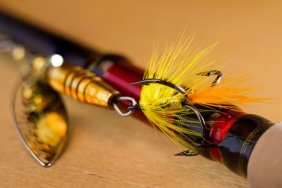
Whether you live on the West Coast or near the Great Lakes, fall is the time for Pacific salmon as they make their annual journey upstream to spawn, die and continue the cycle of life. Successful salmon fishing during the fall migration is all about timing. It takes a bit of research, combined with a little luck, in order to catch fish.
When Pacific salmon reach the age of reproduction, they are called back to the rivers they hatched in to spawn and die. The biggest key for anglers is identifying rivers that annually have strong runs of salmon and focusing on those waters.
Early in the process the fish stage at the mouths of rivers as they wait for the right conditions to begin their journey upstream. Finding salmon is fairly easy at this point. They can be seen swimming in shallow water and at the surface as they gear up for their big journey. The timing is usually about the same each year for this part of the spawning process. During this staging process, salmon can be taken by trolling, jigging or casting from shore.
For West Coast Pacific salmon, part of the staging process is about transitioning from salt water to freshwater and allowing their bodies to adjust. The other part of the staging process is waiting for the right conditions to spur the migration upstream. These conditions include the right water temperatures and the right flow coming from the rivers. A substantial rainfall is often the spark that sends them upstream. This is especially true in cases where higher river levels and flow are needed for the fish to get past bars at the river mouths.
This is where anglers need a bit of luck. Finding out when the fish are entering the river often requires frequent trips to the river or connecting with a network of anglers to communicate when the fish are moving upstream. Some fisheries departments provide information on salmon movements or historical data, which gives a general idea on when fish typically reach certain areas of a river.
Depending on the river, salmon may swim a few hundred yards or many miles to reach their spawning grounds. The best areas for anglers to focus on, along the river, are falls. Often, salmon are found congregating below falls. In some cases, the falls may be too high for the fish to clear. In other cases, they may be waiting for rainfall and higher river levels, which will allow them to clear the falls. Either way, this provides anglers with access to high numbers of fish that are, for the moment, not moving anywhere.
It is important to note that feeding is not high on the salmon’s list of activities as it moves upstream to spawn. However, the fish will hit baits. One of the most popular techniques for taking salmon in the rivers is drift fishing. This involves casting upstream and letting the current carry your bait downstream. The key here is adding weight to the line to get the bait to the level of the fish, and allowing the weight to bounce along the bottom. The most popular baits are spawn bags or yarn flies. Color can be the most significant factor in enticing the fish to take a bait. Bright oranges, greens and reds are among the top colors, but different colors may work better on different days. If one color is not working, try another. In some cases, darker colors work better.
If you are inexperienced and you find an area where salmon are congregating, there are likely to be many other anglers there as well. Watch what they are doing and ask questions. Many experienced anglers will offer tips that may help you catch more fish.
Fall is an exciting time for salmon anglers, but it is a narrow window of opportunity. The anglers who are prepared and dedicated are likely to catch the most fish.
Photo credit: Dreamstime








